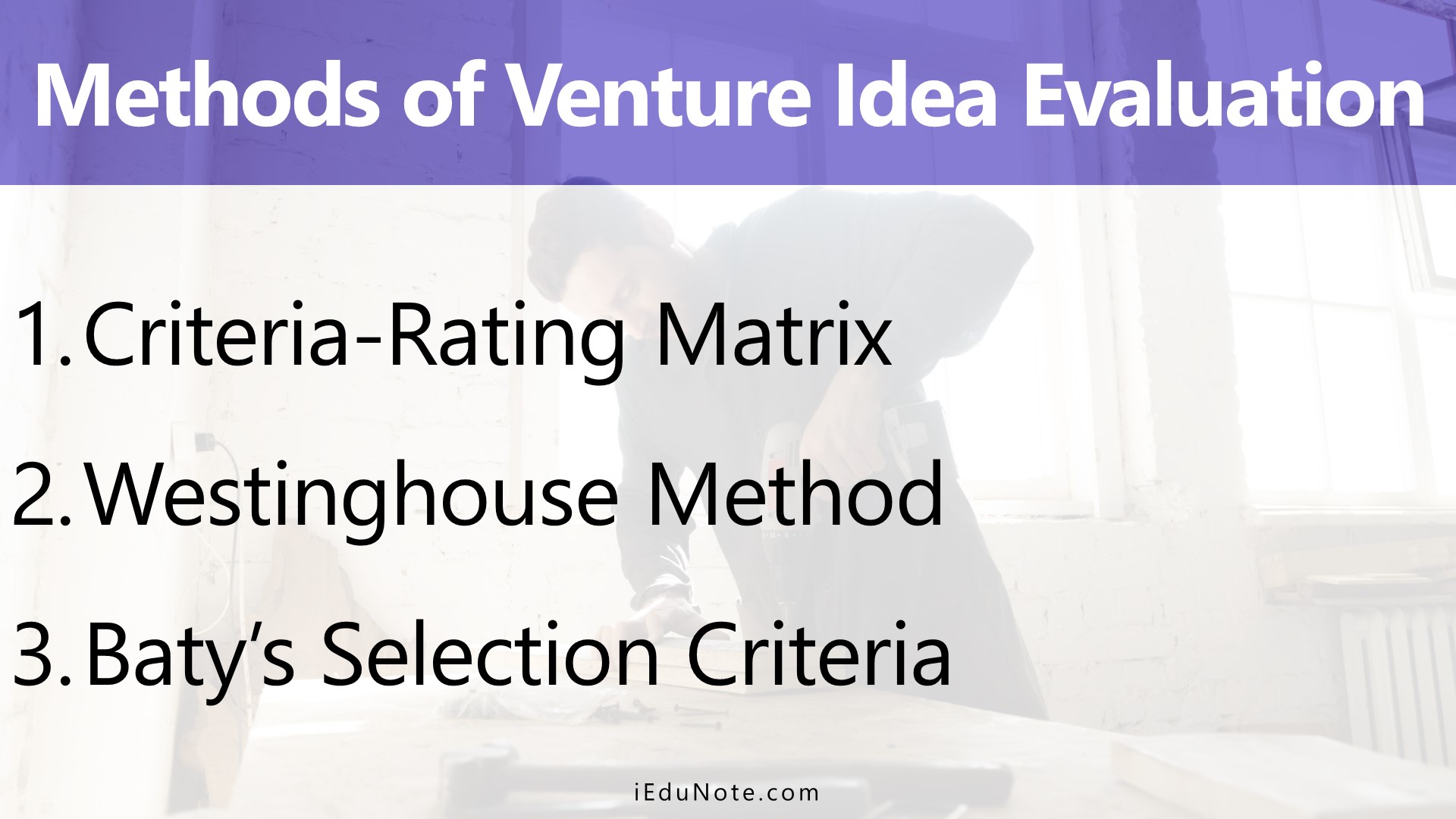The desirability of a venture idea on the above-mentioned considerations can be assessed with several evaluation methods, and it will help entrepreneurs find the big winner.
Some methods are simplistic; others are mechanistic and complex. Some entrepreneurs operate with a single criterion to select viable products or services based on this Wit criterion.
Such as “because we sell through various shopping malls, the products any venture must fit that.”
Some entrepreneurs may only look at the financial side, where a product-service idea must have a minimum side potential of 12 times their investment in 5 to 6 years of venturing. However, the following are some methods that one can find helpful.

Criteria-Rating Matrix
Criteria should be selected that are important to the product-service idea’s success. The criteria rating matrix uses a weighted average on a scale of 3.0 for excellent, 2.0 for good, and 1.0 for fair.
It requires getting responses from as many experts as the entrepreneur can.
Here, negative ratings are excluded as the ideas are primarily selected as viable for evaluation. The venture idea with a higher aggregate weighted average would be chosen in the list of preferences.
The individual item would be assessed on its weighted average.
If a venture idea with an item’ with a low weighted average can be a strong barrier to overcome m future, it should be excluded even if it has a high total weighted average.
|
Ratings of Experts | ||||
| Criteria | Excellent | Good | Fair | Weighted Average |
| Ease of operation | ||||
| Quality and maintainability | ||||
| Marketability | ||||
| Ability to raise capital | ||||
| Return on investment | ||||
| Proprietary status | ||||
| Size of market | ||||
| Simplicity of manufacturing | ||||
| Advertising potential | ||||
| Growth potential | ||||
| Low-risk potential, | ||||
| Consistency with law | ||||
| and government priority | ||||
| Input availability | ||||
| Reasonability of cost | ||||
| Availability of technical | ||||
| know-how | ||||
Westinghouse Method
Westinghouse has worked with a venture-rating system based on a ‘formidable formula’ representing the estimates and knowledge of several contributions.
The formula, which acts as a primitive model, reads like this;

The chances of technical and commercial success of a venture are expressed as percentages, with 100 percent equaling 1.
The average annual sales volume is expressed in units. 1’rice is the net sales per unit in Dollars. Cost is the total Dollar cost per unit.
Venture life is the estimated number of years of the life of the venture business over which the average annual sales volume in the formula can be exported to remain approximately the same.
Total costs are the total Dollar investment in development, including research, design, manufacturing, and marketing. Ilic higher the priority category the formula yields, the stronger the venture idea’s claim to success.
Baty’s Selection Criteria
Gordon B Baty (1974:33-34) has developed a set of criteria of which if venture idea qualifies seven or more of these criteria, that idea will have the business potential.
The criteria are as follows:
- Is it proprietary? The idea must have sufficiently proprietary to permit a long head start against competitors and a period of extraordinary profits early in the venture to offset start-up costs.
- Are the initial production costs realistic?
- Are the initial marketing costs realistic?
- Does your product have the potential for very high margins?
- 5 Is the time required to get to market and break even realistic?
- Is the potential market enormous? For potential market, look ahead three to five years.
- Is your product the first member of a growing family? So much the better if it requires a lot of high-margin accessories or supplies.
- Do you have some ready-made initial customers? It is certainly impressive to financial backers when you can list your first 10 customers by name.
- Are the development costs and calendar lime realistic? Preferably, they are zero. A read) -to-go product gives you a big leg up over competitors.
- Are you in a growing industry? This is not essential if the profits and company growth are there, but there is less room for mistakes.
- Can your product and the need for it be understood by the financial community?
Co-relate opportunities to personal concern or constraints:
Personality should fit with opportunity strongly.
Only co-related opportunities will be finally selected.
So, always low at personal constraints after you have a good glimpse of the potential profit in a business opportunity, as the profit potential may override many of your constraints.
You may wish to impose some personal constraints in your evaluation of an idea to determine further if it is worth your time and effort. Perhaps the idea does not fit with your idea of something you would wish to do.
General personal constraints are related to want, income, time, status, fun, experience, will, knowledge, interest, worth, priority, lifestyle, and legality.
Colombo Plan Staff College for Technician Education has developed the following list of personal constraints questions against which the prospective entrepreneur can evaluate an idea:
- Do I want to do it?
- Do I want to work part-time or full-time?
- Does it have the potential to satisfy my target income/profits?
- Is it worth the effort?
- Is it legal? Within my moral /ethical standards?
- Is it within my status? Will it advance my status?
- Do I want to work with the types of people involved?
- Is the idea high on my list of priorities?
- Do 1 have the time?
- Will it be fun?
- Do I want to live with the lifestyle it will entail?
- Do I have the required knowledge/skill/experience, of., if not.,
- Do I have the lime/interest/ability to leam?
- Do I have the necessary knowledge of markets/suppliers?
- Do I have enough finances available/accessible?
The above process of evaluating a business opportunity and arriving at a decision on starting a business is nothing but a sort of SWOT analysis of the business idea or opportunity, i.e., analysis of Strengths (S), Weaknesses (W), Opportunities (O), and Threats(t) – SWOT analysis is an integrated assessment technique to finally select the most appropriate business opportunity for a given time in given conditions.
Strengths and weaknesses are always related to the individual, or an organization interested in business Opportunities and threats are usually related In the outside environment following is an example:
| Strengths | Weaknesses |
| Pa>t trade experience. | Poor communication skill |
| Capacity to hard work. | Loose temper |
| Good market knowledge. | Deficiency of skills. |
| Managerial education/training. | |
| Adequate fund. | |
| Capacity to accept strangely. | |
| Will to take risks situation. | |
| Opportunities | Threats |
| High aggregate demand in the market. | Competitions |
| No competitions | Harsh retaliation from existing competitions |
| Favorable social acceptance | Market fluctuations |
| Available skills |
Once one has a fair and exhaustive list of each, he/she can then weigh the strengths and opportunities against the weaknesses and threats and see if the positives outweigh the negatives.
It also enables one to think of ways to overcome the risks or threats. An Idea File would be prepared with a list of business ideas and opportunities for an entrepreneur.
Ideally, you should strive to have a list of fifty opportunities for which you have listed the top tea which best fits your constraints and are ripe for exploitation.
This way. When you start to dig deeper into an opportunity and discover it is no longer attractive, you have a reserve supply of other opportunities to fall back on.

